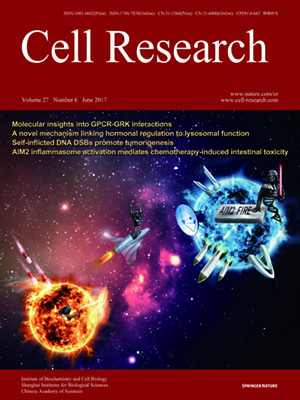
Volume 27, No 6, Jun 2017
ISSN: 1001-0602
EISSN: 1748-7838 2018
impact factor 17.848*
(Clarivate Analytics, 2019)
Volume 27 Issue 6, June 2017: 801-804 | Open Access
ORIGINAL ARTICLES
Homology-mediated end joining-based targeted integration using CRISPR/Cas9
Xuan Yao1,2,*, Xing Wang1,2,*, Xinde Hu1,*, Zhen Liu1,*, Junlai Liu2,3,4, Haibo Zhou1, Xiaowen Shen1, Yu Wei1,5, Zijian Huang1,2, Wenqin Ying1, Yan Wang1, Yan-Hong Nie1, Chen-Chen Zhang1, Sanlan Li1, Leping Cheng1, Qifang Wang1, Yan Wu6, Pengyu Huang3, Qiang Sun1, Linyu Shi1 and Hui Yang1
1Institute of Neuroscience, State Key Laboratory of Neuroscience, Key Laboratory of Primate Neurobiology, CAS Center for Excellence in Brain Science and Intelligence Technology, Shanghai Institutes for Biological Sciences, Chinese Academy of Sciences, Shanghai 200031, China
2College of Life Sciences, University of Chinese Academy of Sciences, Beijing 100049, China
3School of Life Science and Technology, ShanghaiTech University, Shanghai 201210, China
4Institute of Biochemistry and Cell Biology, Shanghai Institutes for Biological Sciences, Chinese Academy of Sciences, Shanghai 200031, China
5Shanghai University, Shanghai 200444, China
6National Institute of Biological Sciences, Beijing 102206, China
Correspondence: Hui Yang, E-mail: huiyang@ion.ac.cn; Linyu Shi, E-mail: shilinyu@ion.ac.cn; Qiang Sun,(qsun@ion.ac.cn)
Targeted integration of transgenes can be achieved by strategies based on homologous recombination (HR), microhomology-mediated end joining (MMEJ) or non-homologous end joining (NHEJ). The more generally used HR is inefficient for achieving gene integration in animal embryos and tissues, because it occurs only during cell division, although MMEJ and NHEJ can elevate the efficiency in some systems. Here we devise a homology-mediated end joining (HMEJ)-based strategy, using CRISPR/Cas9-mediated cleavage of both transgene donor vector that contains guide RNA target sites and ~800 bp of homology arms, and the targeted genome. We found no significant improvement of the targeting efficiency by the HMEJ-based method in either mouse embryonic stem cells or the neuroblastoma cell line, N2a, compared to the HR-based method. However, the HMEJ-based method yielded a higher knock-in efficiency in HEK293T cells, primary astrocytes and neurons. More importantly, this approach achieved transgene integration in mouse and monkey embryos, as well as in hepatocytes and neurons in vivo, with an efficiency much greater than HR-, NHEJ- and MMEJ-based strategies. Thus, the HMEJ-based strategy may be useful for a variety of applications, including gene editing to generate animal models and for targeted gene therapies.
10.1038/cr.2017.76
FULL TEXT | PDF
Browse 1938


